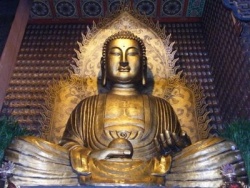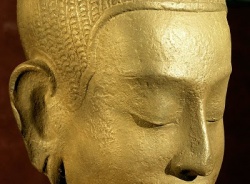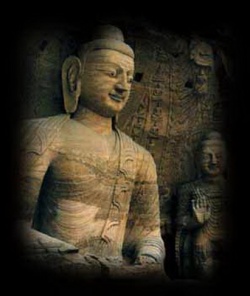Difference between revisions of "Eternal Buddha"
m (Text replacement - "change" to "change") |
m (1 revision: Robo text replace 30 sept) |
(No difference)
| |
Revision as of 16:30, 30 September 2013
The idea of an eternal Buddha is a notion popularly associated with the Mahayana scripture, the Lotus Sutra, and is also found in other Mahayana Sutras.The Eternal Buddha in the Lotus Sutra and Other Mahayana Sutras
The Lotus Sutra portrays The Buddha as indicating that he became Awakened countless, immeasurable, inconceivable myriads of trillions of aeons ("Kalpas") ago and that his lifetime is "forever existing and immortal". From the human perspective, it seems as though The Buddha has always existed. The Sutra itself, however, does not directly employ the phrase "eternal Buddha"; yet similar notions are found in other Mahayana scriptures, notably the Mahaparinirvana Sutra, which presents The Buddha as the ultimately real, eternal ("nitya"/ "śāśvata"), unchanging, blissful, pure Self (Atman) who, as the Dharmakaya, knows of no beginning or end.
The Chinese scholar Tiantai [天台] (538–597) viewd Shakyamuni Buddha of Ch 16 of the Lotus Sutra as a unification of the Three Buddha Bodies. That is, Shakyamuni of Ch 16 possesses all Three Bodies. Other Sutras are taught from the standpoint of a single Buddha Body, but Ch 16 onwards is taught from a unification of the Three.
Commenting on the Mahayana Mahaparinirvana Sutra, Dr. Guang Xing writes:
'One of the main themes of the Mahayana Mahaparinirvana Sutra is that The Buddha is eternal, a theme very much in contrast with the Hinayana idea that The Buddha departed for ever after his final Nirvana. The Mahayanists assert the eternity of The Buddha in two ways in the Mahaparinirvana Sutra. They state that The Buddha is the Dharmakaya, and hence eternal. Next, they re-interpret the Liberation of The Buddha as mahaparinirvana possessing four attributes: eternity, Happiness, self and purity. In other words, according to the Mahayanists, the fact that The Buddha abides in the mahaparinirvana means not that he has departed for ever, but that he perpetually abides in intrinsic quiescence. The Buddha abiding in intrinsic quiescence is none other than the Dharmakaya ... This Dharmakaya is the real Buddha. It is on this doctrinal foundation that the Mahaparinirvana Sutra declares:"the Dharmakaya has [the attributes of] eternity (nitya), Happiness (Sukha), self (Atman) and purity (subha) and is perpetually free from birth, old age, sickness, Death and all other sufferings ... It exists eternally without change ..."' The All-Creating King Tantra additionally contains a panentheistic vision of Samantabhadra Buddha as the eternal, primordial Buddha, the Awakened Mind of Bodhi, who declares: "From the primordial, I am the Buddhas of the three times [i.e. past, present and future]." The Eternal Buddha in Shin Buddhism
In Shin Buddhism, Amida Buddha is viewed as the eternal Buddha who manifested as Shakyamuni in India and who is the personification of Nirvana itself. The Shin Buddhist priest, John Paraskevopoulos, in his monograph on Shin Buddhism, writes:
'In Shin Buddhism, Nirvana or Ultimate Reality (also known as the "Dharma-Body" or Dharmakaya in the original Sanskrit) has assumed a more concrete Form as (a) The Buddha of Infinite Light (Amitabha) and Infinite Life (Amitayus)and (b) the "Pure land" or "Land of Utmost Bliss" (Sukhavati), the realm over which this Buddha is said to preside ... Amida is the Eternal Buddha who is said to have taken Form as Shakyamuni and his teachings in order to become known to us in ways we can readily comprehend.'
John Paraskevopoulos elucidates the notion of Nirvana, of which Amida is an embodiment, in the following terms:
'... [Nirvana's] more positive connotation is that of a higher state of being, the dispelling of Illusion and the corresponding Joy of Liberation. An early Buddhist scripture describes Nirvana as: ... the far shore, the subtle, the very difficult to see, the undisintegrating, the unmanifest, the peaceful, the deathless, the sublime, the auspicious, the secure, the destruction of Craving, the wonderful, the amazing, the unailing, the unafflicted, dispassion, purity, freedom, the island, the shelter, the asylum, the Refuge ... (Samyutta Nikaya)'
This Nirvana is seen as eternal and of one nature, indeed as the essence of all things. Paraskevopoulos tells of how the Mahaparinirvana Sutra speaks of Nirvana as eternal, pure, blissful and true self:
'In Mahayana Buddhism it is taught that there is fundamentally one reality which, in its highest and purest dimension, is experienced as Nirvana. It is also known, as we have seen, as the Dharma-Body (considered as the ultimate Form of Being) or "Suchness" (Tathata in Sanskrit) when viewed as the essence of all things ... "the Dharma-Body is eternity, bliss, true self and purity. It is forever free of all birth, ageing, sickness and Death" (Nirvana Sutra)'
To attain this Self, however, it is needful to transcend the 'small self' and its pettiness with the help of an 'external' agency, Amida Buddha. This is the view promulgated by the Jodo Shinshu founding Buddhist master, Shinran Shonin. John Paraskevopoulos comments on this:
'Shinran's great Insight was that we cannot conquer the self by the self. Some kind of external agency is required: (a) to help us to shed Light on our ego as it really is in all its petty and baneful guises; and (b) to enable us to subdue the small 'self' with a view to realising the Great Self by Awakening to Amida's Light.'
When that Great Self of Amida's Light is realised, Shin Buddhism is able to see the Infinite which transcends the care-worn mundane. John Paraskevopoulos concludes his monograph on Shin Buddhism thus:
'It is time we discarded the tired view of Buddhism as a dry and forensic rationalism, lacking in warmth and devotion ... By hearing the call of Amida Buddha we become Awakened to true reality and its unfathomable working ... to live a Life that dances jubilantly in the resplendent Light of the Infinite.' Eternal Buddha in Nichiren Buddhism
The Nichiren Shu and Kempon Hokke schools of Nichiren Buddhism revere Shakyamuni of Chapter 16 of the Lotus Sutra as the Eternal Buddha. Shakyamuni of Ch 16 is regarded as a Unification of the Three Bodies, as taught by Tiantai. This Saha World is regarded as the True Pure land, because Shakyamuni revealed in the Lotus Sutra that it is His domain, and He remains in the World to preach. Other Buddhas, such as Amida of the Pure land (J. Nembutsu) School, and Mahavairochana of the True Word (J. Shingon) School are seen as provisional manifestations of the Original Buddha Shakyamuni.


